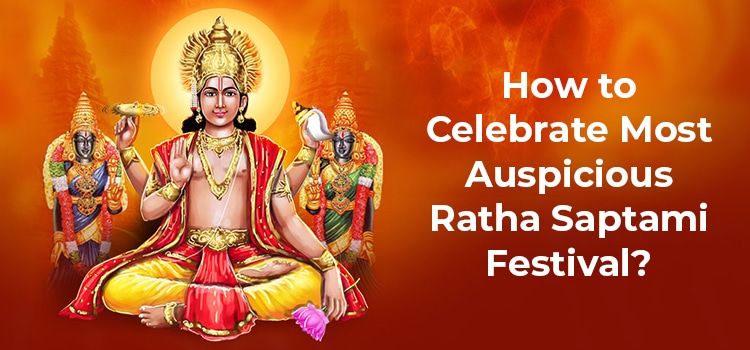What is Ratha Saptami?
India is a land of many festivals, and most of them are religious. This is not surprising as there are 33 crore Hindu gods and goddesses. Hindus celebrate the birthdays of these deities with great fanfare.
Surya Jayanthi or Ratha Saptami is one such auspicious day that celebrates the birthday of Lord Surya or the Sun God. It is observed on the 7th day (Saptami Tithi) of Shukla Paksha (waxing lunar phase) in the month of Magha (Jan-Feb). The belief is that Surya Dev began to illuminate the entire world on this day. It is also called Magha Saptami. Surya was born to Sage Kashyapa and his wife, Aditi.
As per legends, the demons were causing all kinds of troubles for the gods in heaven. Finally, the army of the demons established their kingdom in heaven. This upset the gods, and they sought a solution. So Aditi, the mother of the gods, performed a penance to please the Sun god. Pleased with her penance, Surya appeared before her. He told Aditi that he would be born as her son and protect the gods from the demons.
After some time, Aditi became pregnant. She observed many fasts during her pregnancy to protect her son from danger. On seeing this, Kashyap advised her not to cause stress to her body by observing too many fasts. But Aditi reassured him that no power could destroy her child.
Aditi gave birth to a son, Surya, at an auspicious hour. He grew up and vanquished the army of demons. Ancient scriptures like the Surya Upanishad, Bhavishya Purana, Matsya Purana, Brahma Purana, Markandeya Purana, and Samba Purana have described the glory of the Sun.
It is said that by worshipping Surya and observing Vrat or fast on this day, one can be free of all types of sins.
Ratha Saptami Rituals
On the day of Ratha Sapthami, one should get up before sunrise and take a holy bath. Supposedly, taking a sacred bath at this time can bring relief from all illnesses and bestow good health. So the festival is popularly called ‘Arogya Saptami’.
After the bath, one should offer ‘Arghyadan’ to the Sun God at sunrise. Then one should light a diya or lamp and worship Surya by offering red flowers, camphor, and incense. It is good to chant ‘Gayatri Mantra’ and recite ‘Surya Sahasranaam’, ‘Adityahridayam’ or ‘Suryashtakam’ on this day.
Ratha Saptami is considered to be very auspicious for doing acts of charity. Supposedly, we commit seven types of sins knowingly or unknowingly, by words, body, or mind, in our current as well as previous births. Such sins can be purged by worshipping Surya on Ratha Saptami.
Items required for the Ratha Saptami Pooja
These are the essential things you need for the Ratha Saptami Pooja:
Idol, image, or painting of the Sun God.
Leaves and fragrant flowers used for Poojas.
Green Bananas.
Uncooked rice.
Common fruits.
Coconut
Sesame seeds
Betel nuts
Betel leaves
Turmeric powder
Sugar (jaggery)
Mango leaves
Rituals of Ratha Saptami Pooja
Clean the house thoroughly and place mango leaves on all the main areas early in the morning or the previous evening. Then, begin the Ratha Saptami Pooja by lighting a lamp and offering a simple prayer to Lord Ganesha. You can also pray to your family deities at this time. Arrange the flowers and turmeric-mixed uncooked rice near the idols of Ganesha and Surya Dev. Begin the Pooja for Surya Dev by smearing Surya’s chariot or Ratha with kumkum and turmeric. It can be done on the idol or the image that you use for the Pooja.
Next, keep the flowers, jaggery, turmeric-mixed uncooked rice, and lentils on the Ratha (chariot). Offer betel nuts, betel leaves, milk, fruits, bananas, and coconut to the deity. You can also have a simple Pooja by chanting the Gayatri mantra and offering flowers. Now offer the Aarti. Following this, chant the Surya mantra or Aditya Hridayam. You can also meditate for a while.
Observing a vrat or fast on Ratha Saptami is good for attaining health and success. According to your capacity, you can observe a day-long fast or from sunrise to sunset. On Ratha Saptami, people use the leaves of the arka or erukku plant (Giant milkweed) during their bath.
Married women should place 7 erukkam leaves on their body. On top of the leaf, they should place a pinch of turmeric and some raw rice. One leaf is placed on the head, two on the shoulders, two on the knees, and two on the feet during the bath. Men take a bath with only erukkam leaves and rice without turmeric.
Once the Ratha Saptami Pooja gets over, Chakkara Pongal ( sweet rice) and Vadas are offered as naivedyam to the deity along with coconuts, bananas, betel leaves, and other fruits.
Mantras to be chanted on Ratha Saptami
There are two Mantras that one can chant on Ratha Saptami. One should be chanted when taking a bath, and another during Arghyadan or the ritual of offering water to the Sun.
Snana Sankalpa Mantra (chant during bath)
YadyajjanmakRutam paapam mayaa saptasu janmasu |
tanmE rOgam cha shOkam cha maakarI hantu saptamI |
EtajjanmakRutam paapam jachcha janmaantaraarjitam |
manOvaakkaayajam yachcha jnaataaj Jnaatam cha yatpuna: |
iti saptavidham paapam snaanaanmE sapta saptakE |
saptavyaadhisamaayuktam hara maakari saptami |
Soorya Arghya Mantra (chant during Arghyadan)
SaptasaptivahaprIta saptalOkapradIpana |
saptamI sahitO dEva gRuhaaNaarGyam divaakara |









Comments & Discussion
9 COMMENTS
Please login to read members' comments and participate in the discussion.